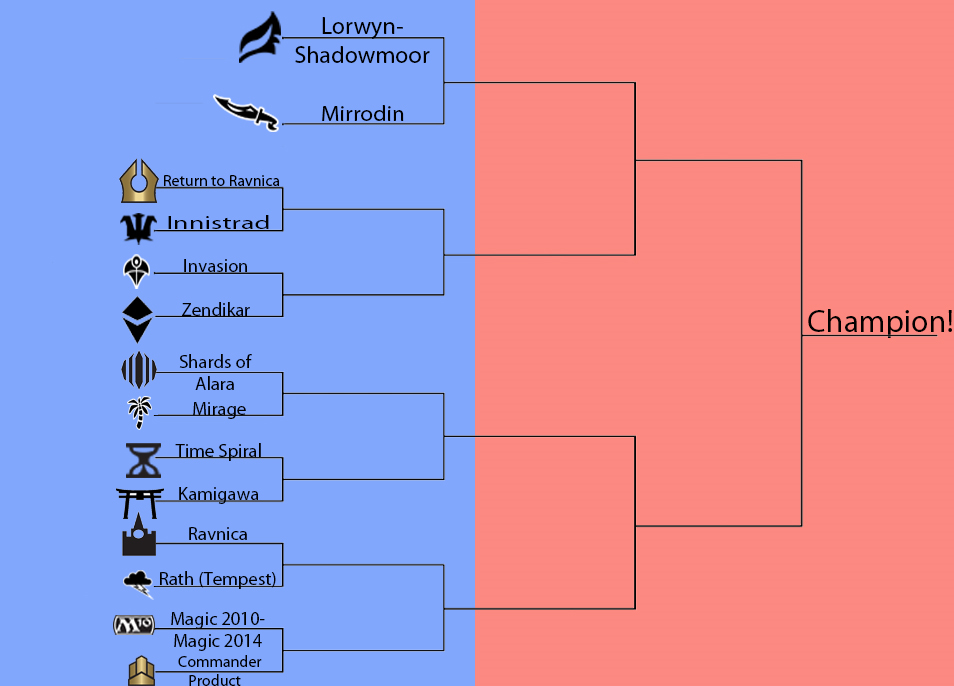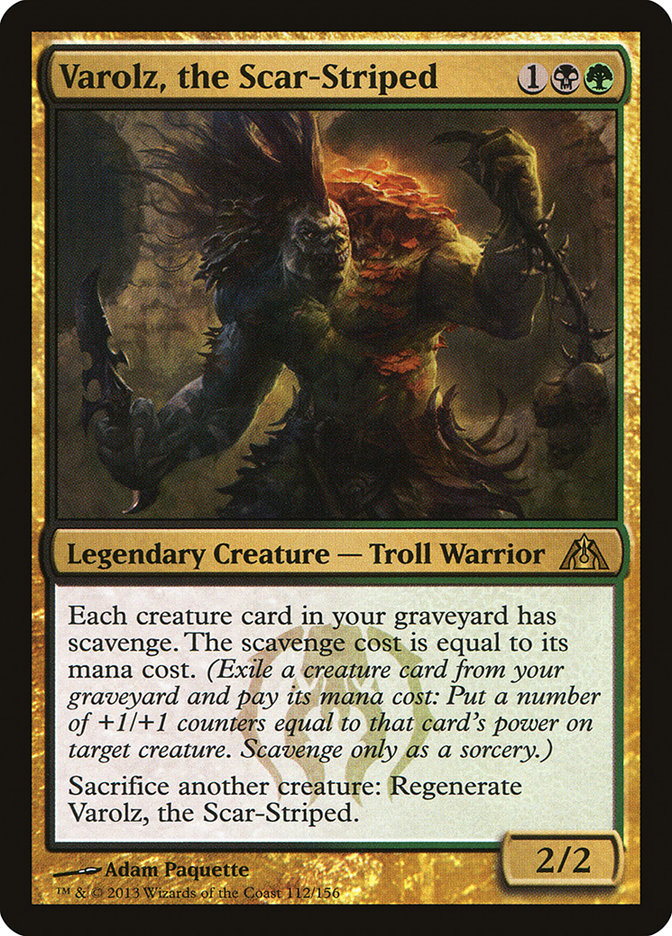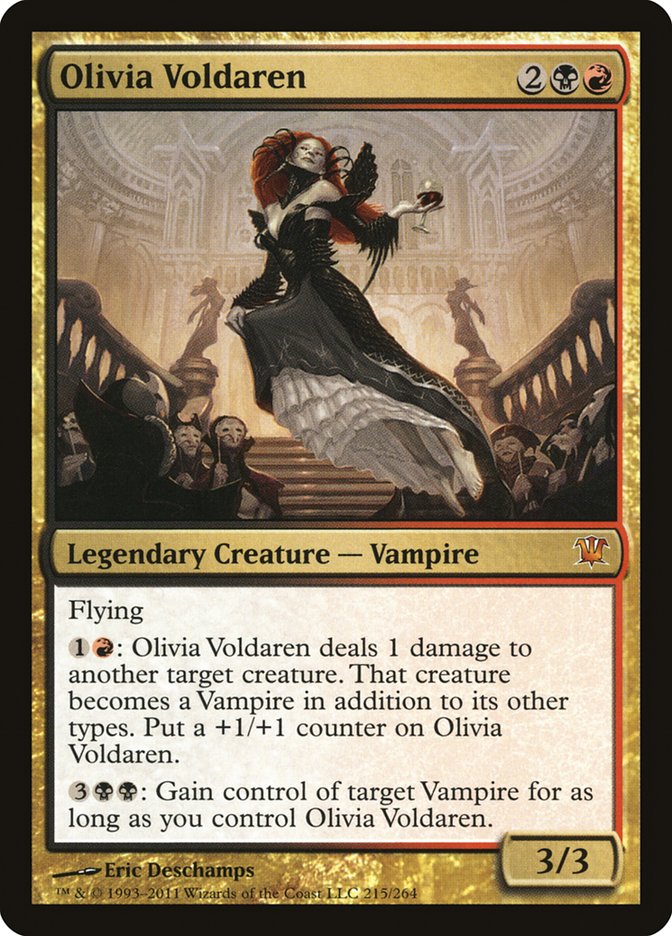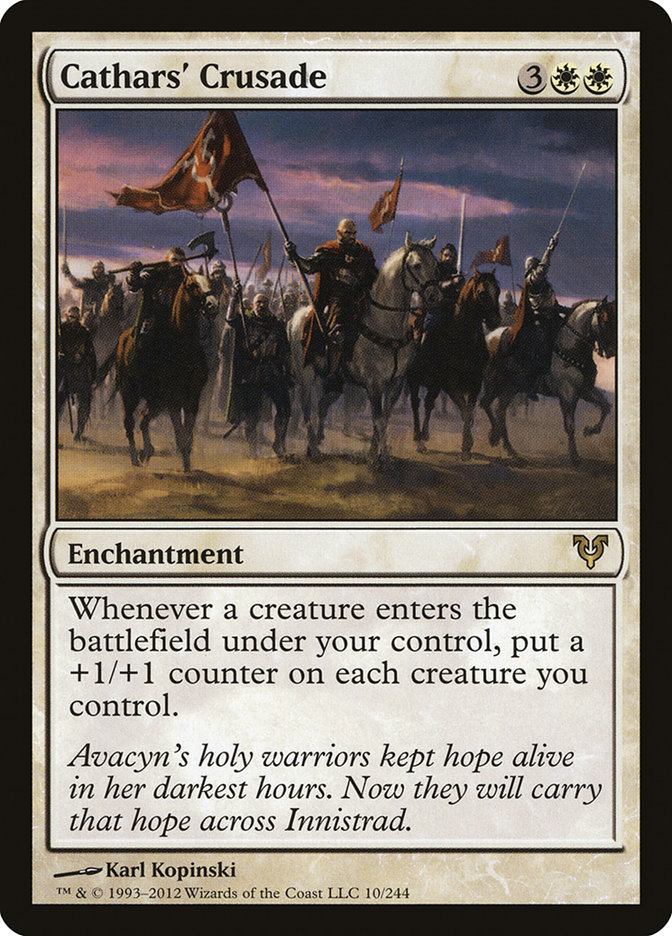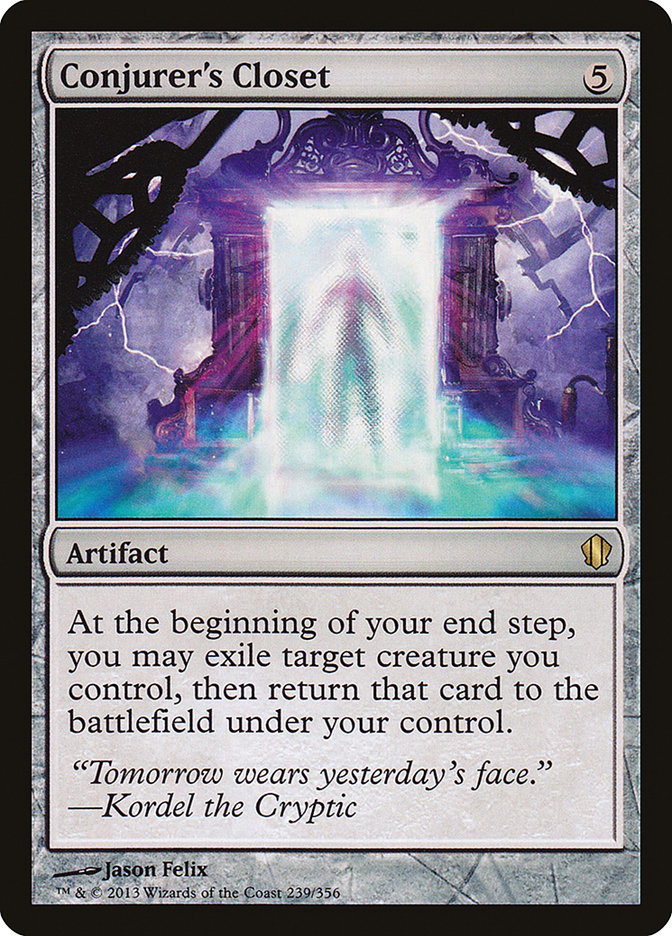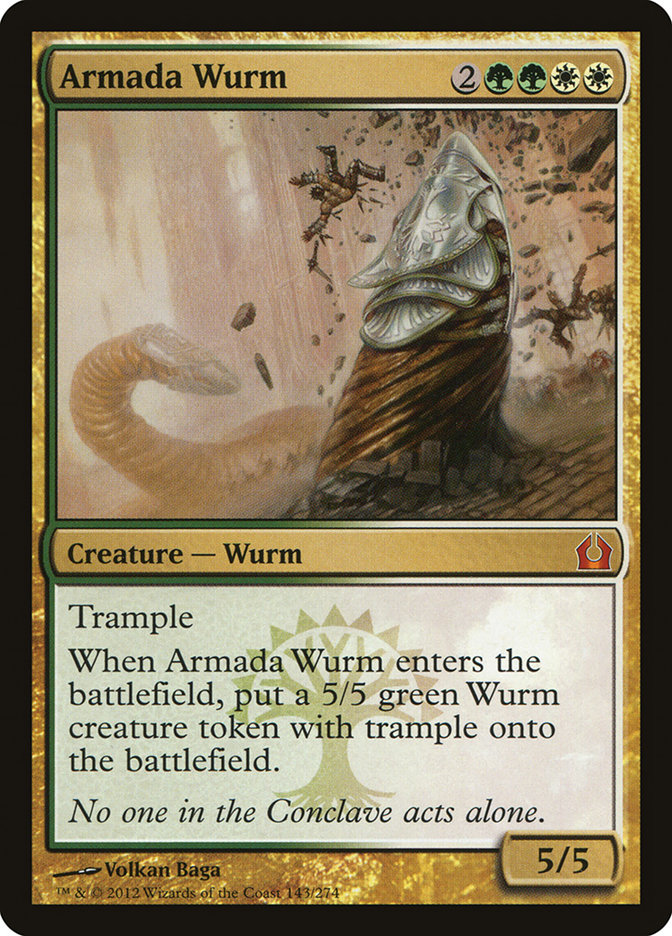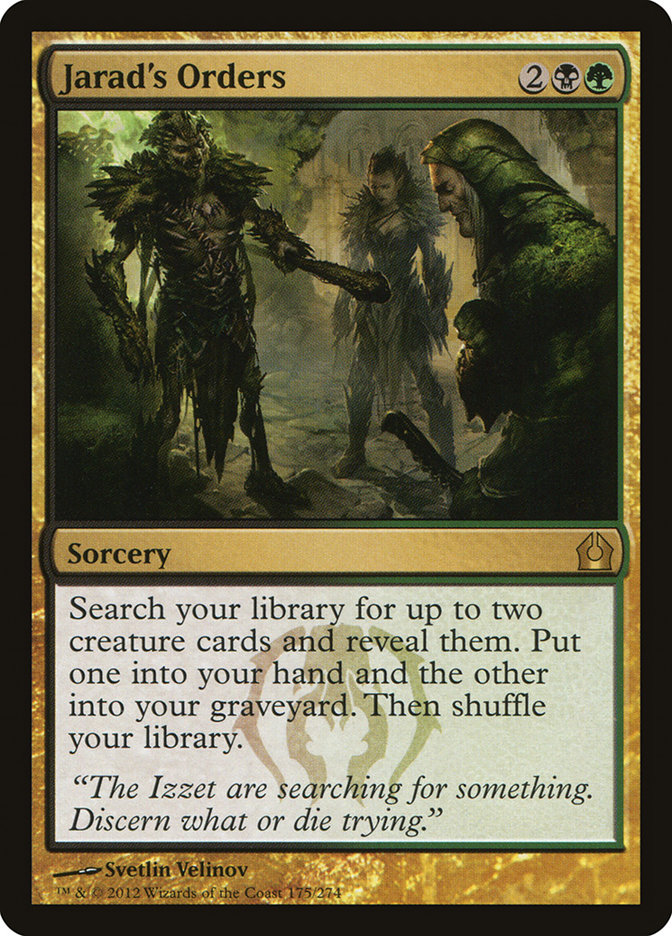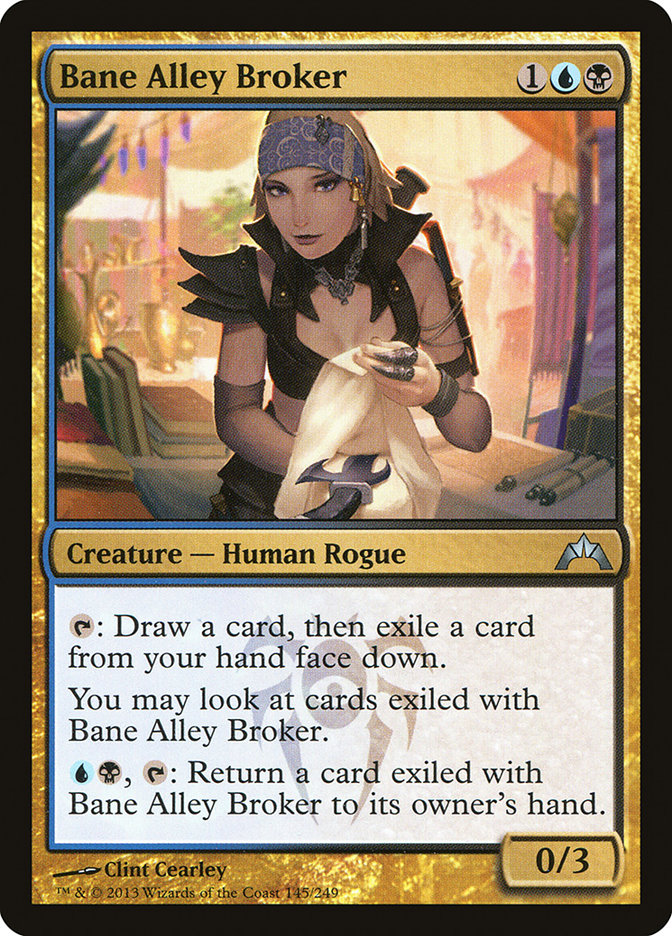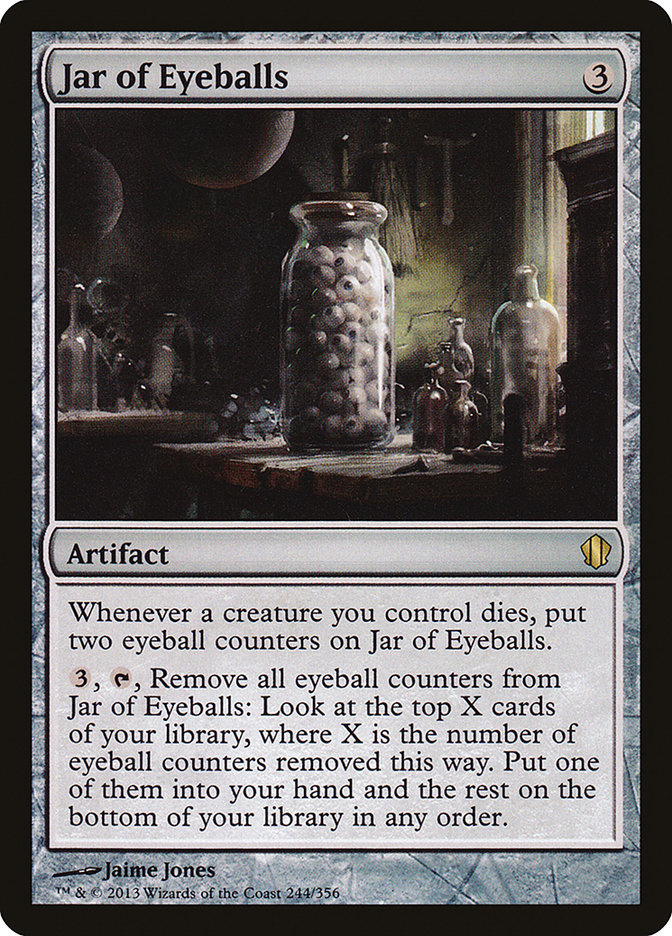This week’s battle is between number-three seed Return to Ravnica and the battle-hardened Innistrad block. This matched pair of blocks composed last year’s Standard and brought dense control decks and interesting aggressive decks to the format. Focusing on these blocks for Commander, Return to Ravnica earned its high seed by bringing two important things to the competition: a heavy dose of new mechanics and a strong multicolored theme.
Each new mechanic belonged to a specific guild composed of a two-color pair and personified the flavor of that guild, melding flavor to functionality. The guild system of Ravnica forced the set to have a strong multicolored theme, creating a treasure trove of cards for allied- and enemy-colored decks in Commander. The guild leaders and guild champions found their way onto the battlefield as legendary creatures and immediately created a splash in the Commander format with their interesting abilities. Return to Ravnica block is positioned as a heavy contender for the title of "Best Block For Commander" due to its profusion of new commanders and strong spells.
Innistrad block triumphantly returns to the Battle Of The Blocks arena as the winner of the Ice Age vs. Innistrad melee. Innistrad block, composed of Innistrad, Dark Ascension, and Avacyn Restored, brought double-faced cards, a strong tribal theme, a few interesting new mechanics, and the return of flashback. Gothic horror finally found a home in this block filled with vampires, zombies, and werewolves, using mechanics like undying to represent the rather persistent monsters within the bramble-wrought forests and sunken moors of Innistrad.
Most people will remember this block for bringing Delver of Secrets, Snapcaster Mage, and Geist of Saint Traft to Standard, Modern, and Legacy tables, but Commander players will remember the interesting legendary creatures and versatile spells that crawled from the catacombs of these sets.
Before we dive deeper into these two sets, let’s take a quick look at the current bracket.
Remember, these battles are to decide which block contributed the most to Commander, not the best block in all of Magic. They will be compared in the usual five categories: Staples, Commanders, Strategies, Flavor, and The Bad.
Staples
Five Notable Staples From Innistrad Block
1) Snapcaster Mage
2) Off-Color Check Lands
3) Blasphemous Act
4) Utility Lands
5) Deadeye Navigator
Staples of the Commander format, as talked about in this recent [author name="Sheldon Menery"]Sheldon Menery[/author] article, are cards that perform their function at the highest level. A spell like Snapcaster Mage allows decks to easily rebuy important instants and sorceries for the low cost of two mana at instant speed, something unmatched by other cards in the format. Without lands, spells are uncastable, and the high quality enemy buddy lands from Innistrad block are relatively inexpensive and help enemy-colored decks fix their mana without the cost of a spell slot. This increased functionality is compounded with the ingeniously named utility lands from Innistrad block that bring the function of an entire spell into a deck without heavily impacting the mana base.
Avacyn Restored brought a new wording to Flicker effects that returns the exiled creature to the battlefield under your control, not its owner’s control. This small change in wording granted greater utility to Deadeye Navigator, affording it the ability to gain control of creatures permanently off of momentary control-seizing effects like Threaten. This permanent Mind Control ability paired with its repeatable Flicker effect turns the blue six-drop into an all-star for decks that utilize enter the battlefield and leave the battlefield abilities and an inclusion at the number-five position.
Five Notable Staples From Return To Ravnica Block
1) Chromatic Lantern
2) Cyclonic Rift
3) Sylvan Primordial
4) Supreme Verdict
5) Guildgates, Keyrunes, Cluestones
The multicolored focused Return to Ravnica block brought some of the best and currently cheapest forms of mana fixing to Commander. The amazing artifact Chromatic Lantern not only ramps players a turn ahead but transforms each land into a Command Tower. The Guildgates, Cluestones, and Keyrunes continue this batch of inexpensive color fixing found in Return to Ravnica block, helping nongreen decks create a more consistent mana base. Chromatic Lantern earned the number-one spot on this list by being instrumental to any deck that plays three colors or more; I suggest buying them now before they go up in price!
Supreme Verdict will not see as much play as Wrath of God due to its multicolored mana cost, but in the decks that can play it, the assuredness of Supreme Verdict resolving propels it into the limelight of the format. The entire Primordial cycle is commonly found on kitchen tables around the world. The multitasking of Sylvan Primordial through noncreature destruction and land ramping is the reason it grabs the number-three spot and will be in Commander decks for years to come.
This section is rather close, but the mana fixing from Return to Ravnica block as well as heavy hitters like Cyclonic Rift and Sylvan Primordial edge out the Snapcaster Mage led Innistrad block.
Commanders
Commanders bring the flavor of the blocks they hail from to life, whether it’s the regimented guild structure of Return to Ravnica or the gothic horror of Innistrad block. Return to Ravnica mirrored its predecessor Ravnica block by creating a legendary creature for each guild leader and one for each guild champion. These twenty legendary creatures bring new strategies to Commander, facilitating interesting deck designs and new avenues for exploration. The basic abilities that these commanders offer, like Melek, Izzet Paragon’s ability to copy spells and Varolz, the Scar-Striped’s ability to scavenge out of the graveyard, allow smart deck designers to wield their commanders as tools to create ingenuous Commander compositions.
The legends of Innistrad bring the macabre to the command zone, with generals like the bloodthirsty Olivia Voldaren and unstoppable Grimgrin, Corpse-Born being the catalyst for most tribal Zombie and tribal Vampire decks. Olivia Voldaren also sees play as a death-dealing machine of destruction in a R/B Control deck that uses deathtouch and cards like Braid of Fire to control the board.
If there is a fault in the commanders of Innistrad block, it is that they are either very linear or don’t lend themselves to an actual deck. Decks built around Bruna, Light of Alabaster or the aforementioned Grimgrin, Corpse-Born follow the same path each game by trudging out Zombie after Zombie or by playing Auras and swinging with Bruna. On the other end of the spectrum, creatures like Sigarda, Host of Herons and Mikaeus, the Lunarch leave the player without a true direction to follow and build around. Not all of the commanders from Innistrad block fit this description; I mentioned the multiple paths of Olivia Voldaren, and the angelic Gisela, Blade of Goldnight always surprises when entering the command zone.
When comparing the two set’s legends, the diversity within Return to Ravnica block supersedes Innistrad block’s resonant card design and takes this round.
Strategies
When looking at the strategies bolstered by Innistrad block, the first thing that comes to mind is tribal; Zombies grabbed Diregraf Captain and Rooftop Storm, Vampires were gifted the powerful Stromkirk Captain, and Humans even found a reanimation element in Angel of Glory’s rise. Yet this set didn’t just help tribal; token decks received Cathars’ Crusade, Parallel Lives, and Champion of Lambholt and found a red finisher in Burn at the Stake.
With the release of Avacyn Restored, blink decks like Roon of the Hidden Realm gained Deadeye Navigator, Conjurer’s Closet, and Nephalia Smuggler to complement the great enters-the-battlefield abilities that surge through these builds. To round out this section, one of my favorite decks, Shirei, Shizo’s Caretaker, and other grindy sacrifice-based builds were given an actual win condition in the life-stealing Blood Artist and Falkenrath Noble.
The guild system within Return to Ravnica block allowed wizards to highlight specific play styles, and each of those strategies was greatly improved by this design decision. The overwhelming support for token decks from Selesnya in Vitu-Ghazi Guildmage, Armada Wurm, and Grove of the Guardian really cemented the deck as a defined strategy in the Commander format. Mill players cheered the return of Dimir and the new grind mechanic to efficiently destroy opponents’ decks with Consuming Aberrations, Mind Grind, and another win condition in Duskmantle Guildmage. The Golgari brought Jarad’s Orders to reanimation decks, and the Orzhov created an entire strategy in extort-based decks.
When looking at the two sets next to each other, the jack-of-all-trades Return to Ravnica block keeps winning with its contribution to so many important Commander strategies.
Flavor
Return to Ravnica is a revisiting of one of the greatest blocks in Magic: The Gathering history, Ravnica block. The plane of Ravnica is a huge city-world covered in sprawling cityscapes that is held in a tense balance by the guildpact forged between the ten color-pair guilds. This metropolitan flavor is very hit or miss on the actual cards from the set; cards like Street Sweeper and Bane Alley Broker showcase the hustle and bustle of Ravnica but rarely see play in Commander. The awesome lore that reaches its way to tables is through the guilds, not the city. A Fathom Mage reminds players of the Simic labs where evolving and learning is of paramount importance, while a Wayfaring Temple displays the power and solemnity of the Selesnya.
When I last went over Innistrad, I mentioned the incredible job Wizards of the Coast did in designing the spells of Innistrad to be an interpretation of classic horror tropes. Pumping mana into a Ludevic’s Test Subject and transforming it into a Ludevic’s Abomination makes the player into the mad scientist and is why the transform mechanic was a success. Even with the wonky triggers for the Werewolves of Innistrad, creatures like Mayor of Avabruck really felt like the classic horror race when they flipped over and pummeled the opponent into the ground. One of the best top-down cards, Jar of Eyeballs, also comes from this block and finishes out this section as a prime example of great design work.
Innistrad handily wins this section by representing the amazing flavor within gothic horror and the groundbreaking transform mechanic!
The Bad
Return to Ravnica is the most recent block in the Battle Of The Blocks and hasn’t placed a single card on the Commander banned list. There are two cards that I’ve heard rumblings about from the player base though: Cyclonic Rift and Sylvan Primordial. Cyclonic Rift is an amazingly powerful spell that allows experienced players to Evacuation the opposition’s board and swing in for lethal without any permanents to stand in their way. The main criticism against this card is that it is highly uninteractive and is an instant-speed version of board removal at a manageable cost in Commander.
Sylvan Primordial also garners hate at some tables and was on my short list of possible bannings until a clarification came up in Gatherer. Sylvan Primordial destroys up to one noncreature permanent; it does not require the usage of its ability, meaning that if an opponent is light on lands, I suggest not destroying their lands and sticking to problematic enchantments and artifacts instead.
When Innistrad block opened up the Helvault and brought Avacyn Restored to the table, a couple of Demons catapulted onto the Commander field with all those Angels. Griselbrand, the eight-mana flier with lifelink, trample, and the ability to draw a new hand at will, was unsurprisingly banned in Commander after his combination of qualities made him way too powerful. Craterhoof Behemoth also rampaged out of the Helvault with an almighty smash and has been ending games early for the past two years. This repeatable Overwhelming Stampede on a hasty five-power creature is so good that every Tooth and Nail and Defense of the Heart morphed into a one-card combo that can wipe out an entire table in a single turn.
The worst of Innistrad came from Avacyn Restored, and even the angels couldn’t save it from this verdict. Return to Ravnica has dealt far less damage to the format than Innistrad block and wins this section.
The previously untested Return to Ravnica block wins this round against the battle-scarred Innistrad block by adding more diversity to the format and helping players craft stronger mana bases. Next time Battle Of The Blocks will feature the powerful Invasion block going head-to-head against Mark Rosewater brainchild Zendikar block.
Do you think I got it wrong? Should Innistrad block have won? Let me know in the comments!

